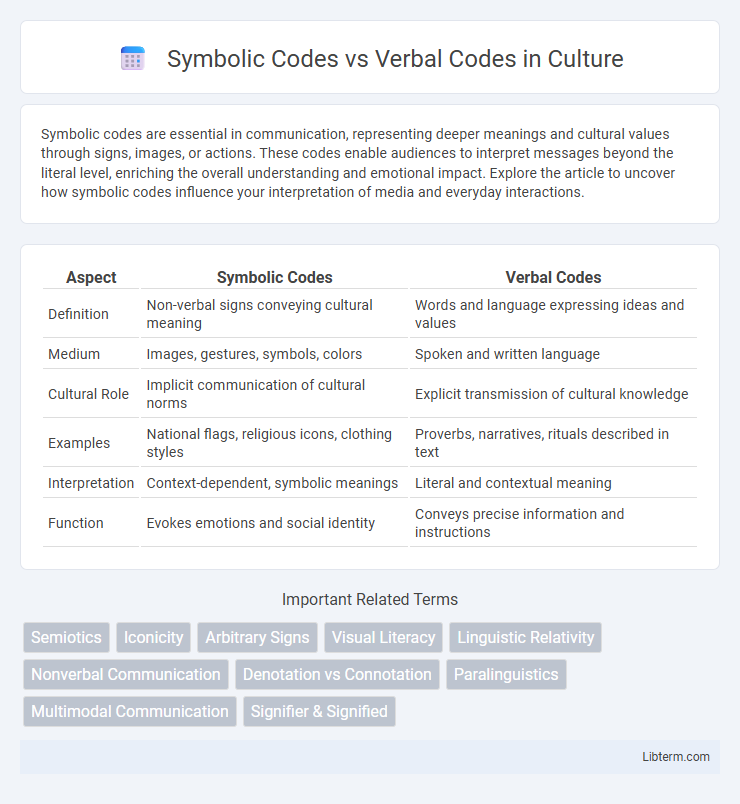Symbolic codes are essential in communication, representing deeper meanings and cultural values through signs, images, or actions. These codes enable audiences to interpret messages beyond the literal level, enriching the overall understanding and emotional impact. Explore the article to uncover how symbolic codes influence your interpretation of media and everyday interactions.
Table of Comparison
| Aspect | Symbolic Codes | Verbal Codes |
|---|---|---|
| Definition | Non-verbal signs conveying cultural meaning | Words and language expressing ideas and values |
| Medium | Images, gestures, symbols, colors | Spoken and written language |
| Cultural Role | Implicit communication of cultural norms | Explicit transmission of cultural knowledge |
| Examples | National flags, religious icons, clothing styles | Proverbs, narratives, rituals described in text |
| Interpretation | Context-dependent, symbolic meanings | Literal and contextual meaning |
| Function | Evokes emotions and social identity | Conveys precise information and instructions |
Understanding Symbolic Codes: Definition and Examples
Symbolic codes refer to systems of signs and symbols that convey meaning beyond their literal form, often used in visual media, literature, and communication to represent complex ideas and cultural values. Examples of symbolic codes include colors, shapes, gestures, and icons, such as the red rose symbolizing love or a dove representing peace. Understanding symbolic codes enhances interpretation skills by decoding underlying messages embedded in artworks, advertisements, and social interactions.
What Are Verbal Codes? Key Features and Functions
Verbal codes consist of language-based symbols such as words and phrases used for communication and information processing. Key features include syntax, semantics, and phonology, allowing individuals to convey precise meanings and complex ideas through structured speech or writing. Functions of verbal codes mainly involve encoding thoughts, facilitating social interaction, and supporting cognitive tasks like reasoning and memory.
Theoretical Foundations: Semiotics and Communication Models
Symbolic codes and verbal codes are grounded in semiotic theory, where symbolic codes represent meanings through signs and symbols beyond literal language, while verbal codes rely on spoken or written language structures. Communication models such as Piercean semiotics emphasize the triadic relationship between the sign, its object, and the interpretant, highlighting how symbolic codes carry connotative meanings within cultural contexts. Shannon and Weaver's communication model primarily addresses verbal code transmission by focusing on message encoding, channel, and decoding, yet it can be extended to interpret symbolic codes as non-verbal signal processing.
Symbolic Codes in Visual Communication
Symbolic codes in visual communication involve the use of images, icons, colors, and shapes to convey meaning without relying on words, enabling universal understanding across different languages and cultures. These codes tap into cultural, emotional, and psychological associations to create immediate recognition and interpretation, such as red symbolizing danger or a heart representing love. Understanding symbolic codes enhances the effectiveness of branding, advertising, and user interface design by leveraging visual elements to communicate messages quickly and memorably.
Verbal Codes in Spoken and Written Language
Verbal codes in spoken and written language rely on structured vocabulary, syntax, and grammar to convey precise meaning and facilitate effective communication. Spoken verbal codes emphasize phonology, intonation, and temporal flow, whereas written verbal codes utilize orthography, punctuation, and spatial organization to enhance clarity and retention. Both forms of verbal codes enable complex expression, abstract reasoning, and the transmission of cultural knowledge across contexts and generations.
Differences Between Symbolic and Verbal Codes
Symbolic codes convey meaning through images, signs, or symbols that require interpretation beyond literal language, while verbal codes rely on words and spoken or written language for direct communication. Symbolic codes often evoke emotions and abstract ideas by using visual or sensory elements, whereas verbal codes provide explicit information through syntax and vocabulary. The primary difference lies in their mode of representation: symbolic codes represent concepts visually or symbolically, whereas verbal codes utilize linguistic structure and semantics.
How Symbolic Codes Influence Meaning
Symbolic codes use images, colors, and gestures to convey meaning, impacting audience interpretation through cultural and contextual associations. These codes create layered interpretations by evoking emotions and subconscious responses that verbal codes may not achieve. Symbolic codes enhance communication by embedding deeper significance within visual elements, shaping message reception and comprehension.
The Role of Verbal Codes in Effective Communication
Verbal codes play a crucial role in effective communication by providing clarity and precision through structured language and syntax. They enable the explicit expression of ideas, emotions, and instructions, facilitating mutual understanding and reducing ambiguity in interpersonal and mass communication. Mastery of verbal codes enhances message encoding and decoding, ensuring accurate transmission and reception of intended meanings across diverse contexts.
Symbolic and Verbal Codes in Media and Pop Culture
Symbolic codes in media and pop culture rely on imagery, signs, and symbols to convey meaning, enabling audiences to interpret messages through visual metaphors and cultural references. Verbal codes use language-based elements such as dialogue, slogans, and narration to communicate ideas explicitly, shaping the narrative and character development in films, advertisements, and music. Effective media messaging often combines symbolic and verbal codes to enhance emotional impact and audience engagement across diverse platforms.
Practical Applications: Integrating Codes for Enhanced Messaging
Symbolic codes, such as logos and colors, enhance brand recognition by conveying meaning visually, while verbal codes use language to provide clarity and detailed information in messaging. Integrating symbolic and verbal codes in marketing campaigns strengthens engagement by appealing to both emotional and cognitive processing, improving message retention. Practical applications include combining visual symbols with concise slogans in advertisements to create cohesive, memorable brand communication that resonates across diverse audiences.
Symbolic Codes Infographic

 libterm.com
libterm.com